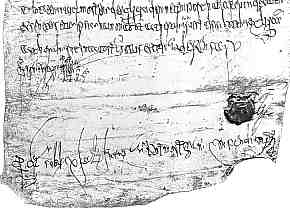
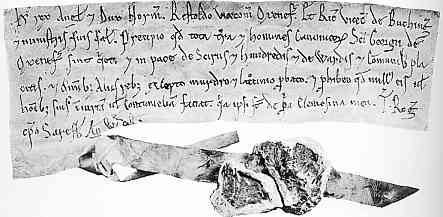
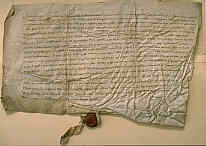
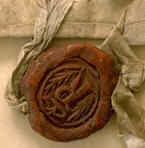
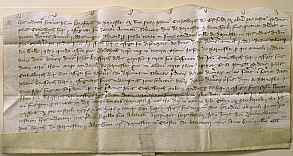

If you are looking at this page without frames, there is more information about medieval writing to be found by going to the home page (framed) or the site map (no frames).
| The Single Sheet (2) | ||
| There were different methods of attaching the seal to the document. In earlier documents from Continental Europe, beginning with diplomas of the Merovingian kings, the seal was single sided and attached to the face of the document. | ||
 |
Bottom of a diploma of the Merovingian king Childebert III from AD 695, showing the seal attached to the face of the document (Paris, Archives nationales, K3, Nr.9). (From Steffens 1929) | |
| The writs of Edward the Confessor, which set out the general form of English royal documents for centuries to come, had the seal attached to a long tail of parchment cut from across the bottom of the sheet. Originally, these documents were folded and wrapped with this tie for delivery. This form of attachment persisted with some documents for some time. | ||
 |
||
| Writ of Henry I to the sheriffs of Oxford and Buckinghamshire (Christ Church, Oxford), with the remnants of the seals attached to a tail on the document. (From Salter 1929) | ||
| In the later middle ages, the most common system was to attach the seal to a parchment tag, which was fastened to the folded up lower edge of the document. | ||
 |
 |
|
| A 15th century private charter on parchment, with the personal seal of the grantor, a member of the Yorkshire gentry, attached by a parchment strip, from a private collection. | ||
| The papal chancery used silk cords rather than parchment tags for the attachment of the seal to highly important documents, and hemp cords for documents of lesser grade. This system was adopted by the German emperors, and occasionally appears in other significant church or secular documents. | ||
| One particular form of single sheet document was originally produced in duplicate. These were documents such as agreements or contracts which entailed an arrangement between two parties. The two copies of the document were written on a single sheet of parchment. Often a word, sometimes chirographum, was written in the space between the two versions, which were then separated with a zigzag cut. Each party took their half of the document, which could be validated by showing that the two pieces fitted together. This was known as an indenture or chirograph. | ||
 |
A 15th century indenture in a private collection. The detail below shows the edge of the document and the row of letters that have been cut through by the zigzag separation. | |
|
|
||
| The earliest personal letters which survive tend to be highly formal documents from significant people on weighty matters. In form, they follow the formal documents of public proclamation, written on one side of a piece of parchment in formal language and authenticated by seal. It is not until very late, around the 15th century, that truly personal letters are encountered in any quantity, in which people discuss their everyday or domestic matters. By this time there was a greater degree of literacy in the community and many people could pen their own letters and sign their names. However, the personal seal had become accepted and essential even so, although it was used to seal up the document rather than be appended to it. Certain formal properties of the medieval legal document survived in the personal letter of quite modern times. | ||
 |
||
| Letter to John Paston III from William Paston III, c.1478 (British Library, add. ms. 27,446, f.18), by permission of the British Library. The blob of sealing wax on the side is no longer recognisable as a seal. | ||
| While many documents were issued in single sheet form, the nature of the process has meant that these have become highly dispersed. There are collections of single sheet documents, archives and collecting institutions having been presented with assortments at various times. However, the content of many of these sheets is now only available as a result of their having been copied into another format. Monasteries and private estates often copied their charters into codex volumes called cartularies. Important individuals like bishops maintained registers containing copies of their correspondence. Single sheet documents issued from authorities like the English royal secretariats were copied onto rolls for archival purposes. This is where much of the information about the nature of the grants and privileges dispersed through the issuing of single sheet documents can be found today. | ||
|
|
||
|
|
||
|
If you are looking at this page without frames, there is more information about medieval writing to be found by going to the home page (framed) or the site map (no frames). |
||